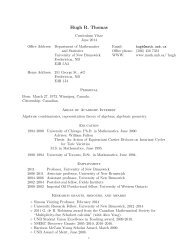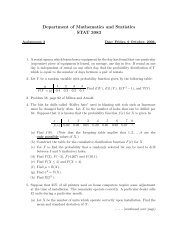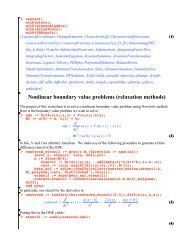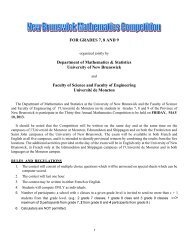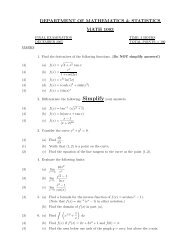Autumn 2003.
Autumn 2003.
Autumn 2003.
You also want an ePaper? Increase the reach of your titles
YUMPU automatically turns print PDFs into web optimized ePapers that Google loves.
Department of Mathematics & Statistics<br />
Stat 2593 Final Examination<br />
13 December 2003<br />
TIME: 3 hours. Total Marks: 75.<br />
You are permitted to use one 8 & 1/2 × 11 “crib sheet” of notes and formulae<br />
in this exam, and a calculator. Any statistical tables that you may need are<br />
amongst those that are attached at the back of the question paper.<br />
Indicate your answers clearly. Show all work.<br />
1. Shipments of drive shafts arrive intermittently at a distribution warehouse. In each<br />
shipment there is a (random) number of used drive shafts; the rest are new. Let X<br />
be the number of used drive shafts in a randomly selected shipment.<br />
Suppose that the probability mass function for X is as given in the following table:<br />
x 0 1 2 3 4 5 6<br />
P (X = x) 0.04 0.13 0.29 0.20 0.13 0.06<br />
(a) What is the probability that X = 1 1 mark<br />
(b) Calculate P (X = 5 | X ≥ 3). (Give your answer to FOUR decimal places.) 2 marks<br />
(c) Are the events “X = 5” and X ≥ 3 mutually exclusive Explain briefly. 1 mark<br />
(d) Are the events “X = 5” and X ≥ 3 independent Explain briefly. 1 mark<br />
2. Let X be a random variable with probability density function 4 marks<br />
f(x) = 3x2<br />
875<br />
for 5 ≤ x ≤ 10<br />
(f(x) = 0 elsewhere).<br />
Let h(X) = 1/(1 + X 3 ). Find the expected value of the random variable h(X). (Give<br />
your answer to FOUR decimal places.)<br />
3. Laxmark Printers buys a shipment of toner cartridges from The Great Australian<br />
Blott Proprietary Ltd. Because of the “Near enough is good enough, she’ll be right,<br />
mate” Australian attitude, 20% of the cartridges produced by the Blott Proprietary<br />
are defective in some way.<br />
(a) Suppose that Laxmark buys 8 of these cartridges. What is the probability that 3 marks<br />
at least 2 of them are defective<br />
(b) Suppose that Laxmark buys 80 of these cartridges. What is the probability that 3 marks<br />
at least 20 of them are defective
4. The following is a stem-leaf plot of the farkling fraction (in furlongs per fortnight) of<br />
a random sample of Lesser Tasmanian Drop-Bears:<br />
MTB > stem c1<br />
Stem-and-leaf of far.frac N = 75<br />
Leaf Unit = 0.10<br />
4 0 2558<br />
12 1 00567899<br />
21 2 011223357<br />
29 3 00136669<br />
(13) 4 0012233566778<br />
33 5 1458<br />
29 6 22459<br />
24 7 446789<br />
18 8 04558<br />
13 9 3<br />
12 10 24468<br />
7 11 1<br />
6 12<br />
6 13 3<br />
5 14<br />
5 15 2468<br />
1 16<br />
1 17 3<br />
(a) Comment briefly on the shape of the distribution of these data. 1 mark<br />
(b) Would it be reasonable to assume that the population of farkling fractions of all 1 mark<br />
Lesser Tasmanian Drop Bears has a normal (Gaussian) distribution Explain<br />
briefly.<br />
(c) Determine the median of this sample. 1 mark<br />
(d) Will the mean of these data be larger or smaller than the median Explain 1 mark<br />
briefly.<br />
(e) The “hinges” (roughly the same as the 1st and 3rd quartiles) of this data set are 1 mark<br />
2.4 and 7.85. What is the very longest that the whiskers of a boxplot of these<br />
data could be<br />
(f) What is the tip (right hand endpoint) of the right hand whisker of a boxplot of 1 mark<br />
these data<br />
(g) What is the tip (left hand endpoint) of the left hand whisker of a boxplot of 1 mark<br />
these data<br />
(h) Are there (according to the boxplot criterion) any outliers in this data set If 1 mark<br />
so, what are their values<br />
2
5. Tensile strength tests were carried out on two different grades (“AISI 1064” and “AISI<br />
1078”) of wire rod. The resulting data were entered into a Minitab worksheet. Given<br />
below is the output of two Minitab analyses of these data. One of the analyses is<br />
CORRECT; the other is SILLY.<br />
MTB > # Analysis number 1.<br />
MTB > TwoSample ’AISI1078’ ’AISI1064’<br />
Two-sample T for AISI1078 vs AISI1064<br />
N Mean StDev SE Mean<br />
AISI1078 129 123.60 2.00 0.18<br />
AISI1064 129 107.60 1.30 0.11<br />
Difference = mu AISI1078 - mu AISI1064<br />
Estimate for difference: 16.000<br />
95% CI for difference: (15.586, 16.414)<br />
T-Test of difference = 0 (vs not =): T-Value = 76.18 P-Value = 0.000 DF = 219<br />
===+===+===+===+===+===+===+===+===+===+===+===+===+===+===+===+===+===+===<br />
MTB > # Analysis number 2.<br />
MTB > let c3 = c1 - c2<br />
MTB > name c3 ’Hi - Lo’<br />
MTB > OneT ’Hi - Lo’<br />
Variable N Mean StDev SE Mean 95.0% CI<br />
Hi - Lo 129 16.000 2.373 0.209 ( 15.587, 16.413)<br />
(a) State which is the correct analysis, explaining why briefly. 2 marks<br />
(b) Using the correct analysis, specify a 95% confidence interval for the population 1 mark<br />
mean difference in tensile strength between the higher grade (AISI 1078) and<br />
lower grade (AISI 1064) wire rods. (Give your answer to THREE decimal<br />
places.)<br />
(c) Should you believe the assertion that on average the higher grade rods exceed 2 marks<br />
the lower grade rods in tensile strength by 10 kg/mm 2 Explain briefly.<br />
NOTE: You will receive ZERO marks for an answer based on the wrong analysis.<br />
6. In a sample of 120 half-inch steel anchor bolts, 102 had shear strength less than or 4 marks<br />
equal to 9.0 kip. Estimate at the 90% confidence level the proportion of all half-inch<br />
steel anchor bolts having shear strength less than or equal to 9.0 kip.<br />
3
7. The unrestrained compressive strength of a particular type of brick has a gamma<br />
distribution with mean equal to 3000 psi and standard deviation equal to 1200 psi. It<br />
is desired to find the probability that the compressive strength is at least 2000 psi.<br />
(a) Find the parameters α and β of the gamma distribution in question. 3 marks<br />
(b) The following Minitab output displays three calculations, one of which is relevant 2 marks<br />
to answering the question of interest, and two of which are SILLY. Making use of<br />
the appropriate portion of the output, find the probability that the unrestrained<br />
compressive strength of a randomly selected brick of the given type is at least<br />
2000 psi. Note: In this Minitab output, k1 and k2 are Minitab constants which<br />
have been assigned the correct values of α and β respectively.<br />
MTB > # First calculation which involved clicking on<br />
MTB > # Probability density. Input constant equal to 2000.<br />
MTB > PDF 2000;<br />
SUBC> Gamma k1 k2.<br />
Probability Density Function<br />
Gamma with a = ******* and b = *******<br />
x f( x )<br />
2.00E+03 0.0003<br />
===+===+===+===+===+===+===+===+===+===+===+===+===+===+===+===+===+===+===<br />
MTB > # Second calculation which involved clicking on cumulative<br />
MTB > # probability. Input constant equal to 2000.<br />
MTB > CDF 2000;<br />
SUBC> Gamma k1 k2.<br />
Cumulative Distribution Function<br />
Gamma with a = ******* and b = *******<br />
x P( X # Third calculation which involved clicking on inverse<br />
MTB > # cumulative probability. Input constant equal to 0.6667.<br />
MTB > InvCDF 0.6667;<br />
SUBC> Gamma k1 k2.<br />
Inverse Cumulative Distribution Function<br />
Gamma with a = ******* and b = *******<br />
P( X
8. A random sample of individuals who drive alone to work in a large metropolitan area<br />
was obtained. Each individual was categorized with respect to size of car driven and<br />
with respect to commuting distance. The resulting table was analyzed in Minitab; the<br />
results (parts of which have been obliterated) are shown below. Row 1 of the table<br />
corresponds to “subcompact”, row 2 to “compact”, row 3 to “midsize” and row 4 to<br />
“full-size”. The column names classify the commuting distance (in kilometres).<br />
MTB > chis c1-c3<br />
Expected counts are printed below observed counts<br />
0-
(b) A plant producing electronic components has samples of 200 components selected 4 marks<br />
daily from its output. The number of non-conforming components is determined,<br />
and the corresponding sample proportion is plotted on a control chart having a<br />
centre line of p = 0.15, an upper control limit UCL = 0.2257, and and a lower<br />
control limit LCL = 0.0743.<br />
Suppose that events take place which cause the proportion of non-conforming<br />
components in the plant’s product to change from 0.15 to 0.10. What is the<br />
probability that a single sample (of 200 components) taken after the change, will<br />
provide evidence that the change has occurred<br />
10. Hexavalent chromium is a carcinogenic air toxin of substantial concern. In a study<br />
on the prevalence of this toxin data were collected on the indoor and outdoor concentrations<br />
(in ng/m 3 ) of hexavalent chromium, at a number of randomly selected<br />
houses in a region of Southern Ontario. One of the objectives of the study was to<br />
demonstrate that, on average, the outdoor concentrations were higher than the indoor<br />
ones. The resulting data were entered into a Minitab worksheet. Given below is the<br />
output (parts of which have been obliterated) of two Minitab analyses of these data.<br />
One of the analyses is CORRECT; the other is SILLY.<br />
MTB > # Analysis number 1:<br />
MTB > TwoSample ’Outdoor’ ’Indoor’;<br />
SUBC> Alternative **.<br />
N Mean StDev SE Mean<br />
Outdoor 33 0.637 0.392 0.068<br />
Indoor 33 0.231 0.128 0.022<br />
Difference = mu Outdoor - mu Indoor<br />
Estimate for difference: 0.4061<br />
*** (Line omitted) ***<br />
T-Test of difference = 0 (vs **): T-Value = 5.65 P-Value = 0.000 DF = 38<br />
MTB > # Analysis number 2:<br />
MTB > let c3 = c1 - c2<br />
MTB > name c3 ’O - I’<br />
MTB > OneT ’O - I’;<br />
SUBC> Test 0;<br />
SUBC> Alternative **.<br />
Test of mu = 0 vs mu ****<br />
Variable N Mean StDev SE Mean<br />
O - I 33 0.4061 0.3920 0.0682<br />
Variable ***************** T P<br />
O - I ***************** 5.95 0.000<br />
. . . . . . (continued over page)<br />
6
10. (Continued.)<br />
(a) State which is the correct analysis, explaining why briefly. 2 marks<br />
(b) On the basis of the (correct) Minitab analysis, state clearly your decision about 1 marks<br />
the hypothesis being tested, at each of the “standard” significance levels, i.e.<br />
0.10, 0.05, and 0.01.<br />
(c) Explain briefly, in a way that a non-statistician could understand, what your 2 marks<br />
decision means.<br />
(d) There were 33 houses involved in the study; if a 34th house were to be ran- 3 marks<br />
domly selected from the given region, between what values would you predict<br />
the outdoor minus indoor difference in concentrations to lie<br />
NOTE: You will receive ZERO marks for an answer based on the wrong analysis.<br />
11. In biofiltration of wastewater, the ambient temperature is known to have a substantial<br />
impact on the efficiency of filtration. In a study done on this subject, data were<br />
collected on the inlet temperature (in degrees C.) and the removal efficiency in percent<br />
for a particular biofiltration facility. A linear regression model to predict efficiency<br />
from temperature was fitted to the resulting data set in Minitab. The resulting output,<br />
parts of which have been obliterated, is shown below.<br />
MTB > set c3<br />
DATA> 9 10.5 14<br />
DATA> end<br />
MTB > regr c2 1 c1;<br />
SUBC> pred c3.<br />
The regression equation is<br />
removal = 97.5 + 0.0757 temp<br />
Predictor Coef SE Coef T P<br />
Constant 97.4986 0.0889 1096.17 0.000<br />
temp 0.075691 0.007046 10.74 0.000<br />
S = 0.1552 R-Sq = 79.4% R-Sq(adj) = 78.7%<br />
Analysis of Variance<br />
Source DF SS MS F P<br />
Regression 1 2.7786 2.7786 115.40 0.000<br />
Residual Error 30 0.7224 0.0241<br />
Total 31 3.5010<br />
. . . . . . (continued over page)<br />
7
11. (Continued.)<br />
Predicted Values for New Observations<br />
New Obs Fit SE Fit 95.0% CI 95.0% PI<br />
1 98.1798 0.0347 ( 98.1090, 98.2506) ( 97.8551, 98.5045)<br />
2 ******* 0.0294 ( *******, *******) ( *******, *******)<br />
3 98.5583 0.0308 ( 98.4953, 98.6212) ( 98.2352, 98.8814)<br />
Values of Predictors for New Observations<br />
New Obs temp<br />
1 9.0<br />
2 10.5<br />
3 14.0<br />
(a) Clearly the inlet temperature must be above freezing for filtration to take place 1 . 4 marks<br />
Suppose that it is claimed that when the temperature is “just marginally above<br />
freezing” the removal efficiency is, on average, at most 97.2%. Check this claim,<br />
on the basis of the available analysis, by testing an appropriate hypothesis. Explain<br />
in one brief sentence your choice of alternative hypothesis. In terms of your<br />
test, does the claim appear to be valid<br />
(Hint: Ignore the fact that if the temperature is 0 ◦ then filtration cannot take place;<br />
i.e. consider “just marginally above freezing” to be 0 ◦ . Then you are testing a<br />
hypothesis about one simple parameter of the model. Which parameter)<br />
(b) Find a 95% prediction interval for a single observation of efficiency when the 3 marks<br />
temperature is 10.5 ◦ C.<br />
(c) Suppose it is claimed that when the temperature is 14 ◦ C. the mean efficiency is 1 marks<br />
98.6% Should you believe this claim Explain briefly.<br />
(d) Suppose it is claimed that when the temperature is 9 ◦ C. the efficiency was 1 marks<br />
observed to take a value of 98.6% Should you believe this claim Explain briefly.<br />
12. Suppose that a 100 metre reel of magnetic tape of a certain type has 25 flaws, on<br />
average.<br />
(a) A 10 metre segment of such tape is selected at random. Under “reasonable” 2 marks<br />
assumptions the number of flaws in this segment of tape has particular wellknown<br />
distribution. Specify this distribution — i.e. give its name and state the<br />
values of any associated parameters.<br />
(b) Calculate (assuming this distribution) the probability that a 10 metre segment 2 marks<br />
of such tape has exactly 2 flaws.<br />
(c) Write down the probability density function for the distance in metres between 2 marks<br />
successive flaws in such magnetic tape.<br />
1 You can’t filter ice, mate!<br />
8



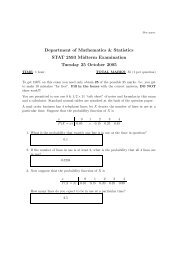
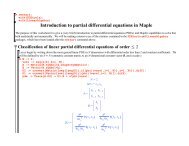
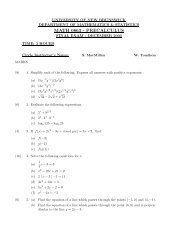

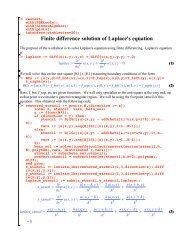
![1]] CHAPTER 2 LIMITS AND DERIVATIVES](https://img.yumpu.com/40053548/1/190x245/1-chapter-2-limits-and-derivatives.jpg?quality=85)

